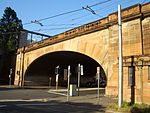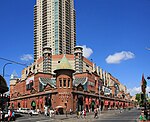Orchard's Chambers
Australian building and structure stubsCommercial buildings completed in 1911Federation Free Style architecture in New South WalesGeorge Street, SydneyNew South Wales State Heritage Register sites located in the Sydney central business district ... and 1 more
Railway Square, Sydney

Orchard's Chambers, also known as Orchard's Corner and Orchard's Building, is a commercial building in Railway Square in the central business district of Sydney, New South Wales, Australia. The building was constructed in 1910 and 1911 to house Richard Orchard's watchmaking and jewellery business, after the original building was demolished to make way for the extension of Quay Street to George Street. It was designed by Sydney architect Ernest Lindsay Thompson.Orchard's Chambers was added to the New South Wales State Heritage Register on 14 December 2012.
Excerpt from the Wikipedia article Orchard's Chambers (License: CC BY-SA 3.0, Authors, Images).Orchard's Chambers
George Street, Sydney Haymarket
Geographical coordinates (GPS) Address Nearby Places Show on map
Geographical coordinates (GPS)
| Latitude | Longitude |
|---|---|
| N -33.8825 ° | E 151.20402777778 ° |
Address
George Street 788-795
2000 Sydney, Haymarket
New South Wales, Australia
Open on Google Maps









